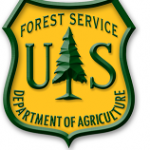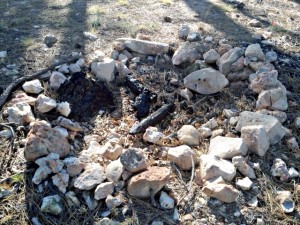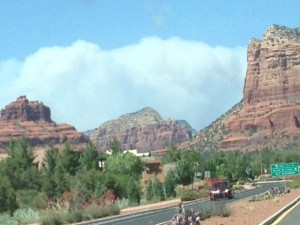 Sedona AZ (June 2, 2014) – The following is a letter to the SedonaEye.com editor about the United States Forest Service (USFS) Forest Management and fire control programs:
Sedona AZ (June 2, 2014) – The following is a letter to the SedonaEye.com editor about the United States Forest Service (USFS) Forest Management and fire control programs:
To: Nicole Branton, District Ranger and Bryan Martyn, Arizona State Parks Director
I intend no disrespect to the employees of the United States Forest Service (USFS) by writing this opinion. I highly commend the agency’s Slide wildfire response. It is miraculous that much of Oak Creek Canyon was saved. My goal is to make the agency a) more effective in preventing devastating wildfires in the future, and b) more transparent and accountable to the public for their actions and, more specifically, for their inactions.
In my opinion, the Slide and Brins fires represent ineffective forest management on the part of the USFS. After Slide Fire response goals are fully accomplished, the USFS must immediately conduct a thorough internal investigation into the effectiveness and prudence of its own policies and practices related to wildfire prevention and control in the Coconino National Forest, and make the results public. This investigation is essentially required under Chapter 5–“Monitoring” under the Forest Management Plan.
When forest vegetation is tinder dry from prolonged drought exacerbated by climate change, and a minor ignition source (like a smoldering cigarette) can ignite and propagate an uncontrolled wildfire, this constitutes an emergency scenario requiring comprehensive emergency mitigating measures. Business as usual is not an option under these conditions. On the morning of the Slide Fire, critical fire weather with strong, gusty southerly winds was predicted by the National Weather Service. Nonetheless, comprehensive emergency mitigating measures were not implemented by the USFS, such as restricting forest access in highly vulnerable Oak Creek Canyon until critical fire weather dissipated. Critical fire weather with similar or worse conditions is predicted for the week of June 2, 2014.
Two destructive wildfires have now occurred in the Sedona/Oak Creek Canyon area in an 8-year period. The Brins Fire burned 4317 acres. The Slide Fire has burned over 20,000 acres. The current USFS policy of allowing unlimited crowds of tourists in the Sedona/Oak Creek Canyon area to have virtually unrestricted access to the forest during a decade-long drought and during critical fire weather must stop. This required change in policy also applies to Arizona State Parks, namely at Slide Rock State Park, where unbridled overcrowding continues to endanger the surrounding forest.
Additionally—-the policy of allowing campfires in developed campgrounds when fire restrictions are in effect is perplexing. Granted, the likelihood of a monitored campfire in a developed campground causing a wildfire is low. However this policy creates the perception among tourists that fire is an acceptable recreational activity in Arizona—just like in wetter, colder, northern climates. I heard a local firefighting official tell a Phoenix TV reporter last week—-“Please come to the Sedona-Flagstaff area, but leave your matches behind”. A very powerful and simple message. It is time for the USFS to get the same message and ban all campfires indefinitely in fire prone areas in the forest—until drought conditions no longer exist.
Every time an accidental fire is ignited and a wildfire results, the USFS is placed in a completely defensive and reactive mode. Aggressive and comprehensive emergency fire prevention measures must be proactively, not reactively, put in place and become part of future USFS policy, such as:
a) restricting forest access during critical fire weather
b) using guided shuttles (like the Grand Canyon National Park) during periods of critical fire weather to transport tourists into the forest, especially Oak Creek Canyon
c) mobilizing large numbers of appropriately trained volunteers to diligently patrol the forests
d) installing widespread educational road signs informing the public of proper fire behavior especially during emergency conditions, using clear and assertive language to convey the serious punishment that will result from unlawful acts.
The USFS receives unrelenting pressure from commercial interests in the Sedona/Oak Creek area to provide unrestricted forest access to all 4+ million tourists visiting the Sedona area each year. The USFS has the authority to override these local commercial interests when needed to help prevent further wildfire catastrophes. This requires resolute conviction and courage. The USFS “Guiding Principles” in its own Forest Management Plan addresses this issue–-“We will not regard the area as a potential theme park for commercial exploitation at the expense of nature. We will not sell the day to profit the hour. “

Fire pits are common sights when hiking in local national forests – this pit at the end of FR 144 with nearby spent gun shells and beer bottles @Sedonaeye.com photo June 1 2014
The USFS for the Coconino National Forest has not performed numerous tasks and requirements of the current Forest Management Plan (FMP) required under the National Forest Management Act (NFMA). Many of these FMP measures would help to mitigate wildfire danger, if not prevent it. The Forest Service must immediately make full disclosure to the public regarding the critical tasks they are not performing and the measures they are not implementing in the FMP. Lack of adequate funding is not a valid excuse for not keeping the public fully informed of FMP inactions.
Full disclosure to the public affords members of the public and other government agencies the opportunity to provide informed input to the Forest Service and to their Congressional representatives, for instance, to request increased funding for the agency. Also this disclosure enables Non-Governmental Organizations (NGO’s) to attempt to secure their own funding to fill in some of the gaps.
Following are some of the FMP control measures and objectives that are not being implemented or achieved by the USFS for portions of the Coconino National Forest, especially the heavily visited Sedona/Oak Creek Canyon area. (Excerpts are used and placed in quotes). This is only a partial list. To the best of my knowledge, no public disclosure of these inactions has occurred.
1) “Where overuse problems are apparent or imminent, use studies are undertaken and remedial action implemented to protect the resource. Possible corrective measures include the initiation of permit systems or seasonal closure of sensitive areas.”
2) “Prohibit National Forest access to Slide Rock recreation area except through the State Park and prohibit parking along State Highway 89A in this vicinity.”
3) Under Fire Management, Planning, and Analysis provisions, the FMP states that for Oak Creek Canyon “the fire suppression objective is to hold fires to 10 acres or less and minimize threat to life and property when fires are a threat. When fires are not a threat to people or improvements, the suppression objective may be increased to 300 acres.”
For Ponderosa Pine and mixed conifer, on all slopes, “the suppression objective is 100 acres or less. Annual average wildfire acreage burned should not exceed 750 acres per year on the average over a 10-year period.”
4) “Consolidate parking where possible to minimize resource impacts in Oak Creek Canyon. Use such methods as alternative modes of transportation, roadside parking limits and parking fees. Develop a strategy to minimize private vehicle traffic and reduce parking impacts, thus improving scenic quality and safety. Encourage alternative modes of transportation that reduce automobile dependency and traffic congestion. Investigate the feasibility of shuttle services for Oak Creek Canyon.”
5) “The recreation experience should not be significantly affected by crowding at recreation sites or on State Highway 89A.”
6) “Work with local and regional governments and road agencies to develop transportation solutions that reduce traffic and vehicle impacts on National Forest lands.”
7) “Consider solutions that restrict recreation site access to shuttle only, provide land for park-and-ride solutions, create incentives for the use of shuttles and other high- occupancy vehicles, place limits and fees on parking; and encourage alternative modes of transportation.
8) “Discourage large group events in the Sedona/Oak Creek Ecosystem”.
9) The Sedona/Oak Creek Planning Area created more specific direction for the Oak Creek research natural area (RNA) in the West Fork of Oak Creek. The FMP states that the RNA is a “superb representative of the area’s natural plant communities. Oak Creek RNA is an example of a biologically diverse creek-side area and is a paleo-botanical area containing plant species surviving from the last ice age.”
Regarding the RNA, the FMP states: “Limit visitor access and use to environmentally acceptable levels to maintain the research values of the RNA. Employ various methods such as using a permit system and providing alternative recreation opportunities and more intense management.”
10) Finally, the USFS provides important guiding principles in Amendment 12 of its FMP.
“Guiding Principles:
We recognize the national and international importance of the Sedona/Oak Creek ecosystem. We respect the links between ourselves, all human activities and the natural world, and realize that the environment is a sensitive and limited living system in need of actions to sustain and enhance it. We will not regard the area as a potential theme park for commercial exploitation at the expense of nature. We will not sell the day to profit the hour. ”
These are lofty, eloquent words —-but unfortunately the rhetoric does not match reality at this time.
I am available at any time to substantially assist the USFS in addressing these issues on a volunteer basis.
Sincerely,
Ron Vernesoni
Environmental Engineer




I’m afraid they have been too busy building restrooms so they can enforce the parking pass that was lawfully taken away a few years back.
The people of Sedona do happily clean up most of the trails in the forest and in return, more and more of the forest is being closed off.
What about the USFS employees?
Cut back on your never ending meetings…This should give the forest service employees enough time to drive themselves in the overabundance of green trucks at the Red Rock Ranger station to the forest and get to work…get a little dirt on those uniforms. Stop spending money on green trucks and hire some help instead.
I was very embarrassed that our Sedona Chamber of Commerce was promoting tourism during what was tested as extremely unhealthy air. One step from hazardous. Someone needs to step down from the Chamber. You know who you are.
@Ron Vernesoni
This is the supreme analysis of the risk inherent in the current fire season coupled with solutions that will work. Thank you Sir. May I add this…I would like to ask if the combined Board of the SFD and the City Council of Sedona would consider, as soon as is bureaucratically possible, one other matter for early-wildfire limitation consideration which may be vital to the survival of Red Rock Country…and, that is, joint venturing between the Sedona Fire District and the City of Sedona in contracting with local private air assets companies, such as Arizona Helicopter Adventures, to provide early wildfire aerial firefighting (including wildfire night-fighting) in order to mitigate wildfires in our general vicinity BEFORE they become a holocaust in the sixty or so hours it usually takes federal and state air assets to arrive on the scene to support the SFD or county firefighters. All monumental wildfires such as the Brins Fire and the recent Slide Fire start small but accelerate quickly.
Sedona is one of a handful of small towns in the country who actually does have this capability sitting right at our own airport. Right here in Sedona, right now, we have the skilled and experienced pilots in day and night fighting of wildfires, the necessary aircraft, save some firefighting add-ons to their aircraft priced at a very reasonable cost, the qualification standards for necessary federal licenses and permits as well as favorable new private contractor provisions under the new federal Incident Command System…not to mention the availability of current water assets they would need vis a vis the Wetlands Preserve. All these Sedona Airport-based aerial firefighters need is some modest funding for firefighting aircraft add-on equipment and on-call firefighting contracts with the SFD and City of Sedona, possibly to be followed by contracts with the counties. The idea is to seriously limit a wildfire’s spread, if not extinguish it outright, before the SFD has to put their firefighters at risk of fighting a holocaust before federal/state air assets arrive, almost always belatedly!
JRN
Where’s the closest helicopter now?
Important Property Owner Information: From Fire to Flooding – Post-Wildland Fire Awareness
Wildfires greatly increase the risk of flooding. To read this important information on the National Flood Insurance Program, please view this brochure or visit http://www.floodsmart.gov.
Of course when R. Adams and “the gang” purchase property on the creek for a park and related walk-way “they” will be miraculously exempt from such disasters as fire and flooding? RIGHT!
Mr. Norman, did they use the wetlands water during this fire? Unsure of that point’s meaning because it is there to use?
@Bill, uptown
No, they did not use the Wetlands Preserve water as far as I know. The point is, though, even if a small town has aerial assets and experienced pilots for airborne firefighting, it has to have a water source as well. We have it!
About joint venturing between the Sedona Fire District and the City of Sedona in contracting with local private air assets companies, since when did the City Council have any control over the operation of the airport? Isn’t that under jurisdiction of Yavapai County and the Airport Authority?
@ Yeah
I was supremely disgusted with the Chamber’s “Visit Sedona” facebook page which continually posted “Come to Sedona, we’re open for business!” during the slide fire. I responded with the truth and they deleted my posts.
Thank you Ron Vernesoni for a well thought out letter with practical solutions.
I’m afraid that the USFS guiding principles will never be practically applied due to the greed of the city and Chamber. They raised the bed tax and gave the Chamber over $1m to attract more visitors. The Chamber continued to encourage visitors in the heat of the devastation with a complete disregard for public safety. They do not give a crap about the forest or the beauty of this wonderful place. They care even less about visitor experience. Who cares if visitors have to sit on HWY 179 for 2 hours to get to uptown, where there is no parking. It’s all about the money with them and to heck with the environment.
I grew up in Southern California and Disneyland was the same way. Instead of closing the park when it’s full, they keep taking your money and you can pay over $100 to ride 2 or 3 rides all day. It’s just not right.
@Question,
The helicopter and fixed-wing aircraft touring companies operating out of the airport are private businesses, and as long as they make there lease payments and don’t violate any safety regulations, they are free to enter into any legal business contracts that they may choose just like any other business.